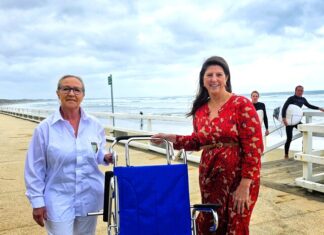 Model citizens: Norm Hatherly, Bob Julian, David Mann and Colin Klein with one of their group’s working models.
Model citizens: Norm Hatherly, Bob Julian, David Mann and Colin Klein with one of their group’s working models.
JOHN VAN KLAVEREN
Most models don’t work – or at least, not much.
But all the models of Geelong Society of Model and Experimental Engineers are working exhibits.
It would make sense to think that members of GSMEE are all involved in engineering in some way.
But they include among their ranks a marine biologist, a clerk, an apicultural officer, a train driver and a boiler attendant as well as a fitter and turner, a tool maker and an electrical engineer.
Group secretary David Mann said the models were built to a scale of 1/12th or smaller.
Members fascination with models mostly sprang from the satisfaction of making them coupled with the joy of sharing the experience.
“If it’s been built, someone somewhere will make a model of it,” David explained.
The group formed 16 years ago from shared interests with the idea of providing a platform for people who tended to craft away in their own workshops.
“If we didn’t have this club our models would be in the dark gathering dust probably,” president Colin Klein laughed.
The club formally states its official reason for existence as: “To provide an opportunity for persons having an interest in experimental science, model engineering and allied handicrafts to meet and exchange ideas on various aspects of their craft, be it design, work methods, experimentation, tools or equipment.”
Last week’s meeting featured displays of three model boilers, two model steam engines, a differential engine harking back to1896, an early 20th Century steam pump, a table engine, a steam locomotive and a tool sharpener and cutter.
David said models were often designed to overcome patents as clever inventors tried to find alternatives for performing similar tasks without being sued.
Many of the Geelong group’s models, which dated from the industrial revolution, were smaller versions of the large and powerful units that formerly ran textile, automotive and power industries.
The range of exhibits was also a record of the history of industrialisation and engineering.
David explained that members made all the components, often using wooden patterns to cast parts, machining the castings and painstakingly crafting all the accessories.
“Most members have private workshops and one member has his own foundry,” David said.
“What we do often covers all the engineering disciplines. Some of these are long-term projects of four to five years.”
Members quipped that their skills often had domestic applications once they heard the common call of “Grandpa will fix it”.
David said the experimental part of the group’s name was also instructive as one member was experimenting with computer numerical control (CNC) machinery – the basis of robotics – and another was toying with electric and hydrogen cars.
The group also took OHS seriously.
“They’re working models, so we have to ensure safety is paramount, just as you would in industry,” Colin explained.
The Geelong club was affiliated with similar clubs in Melbourne and Bendigo where the collective membership ran annual displays.
The club also plans an exhibition for a National Trust Heritage Festival in April along with other groups based at North Geelong’s Osborne House
More information on GSMEE is available by phoning 5277 0580 or emailing geelongsmee@fastmail.fm.






